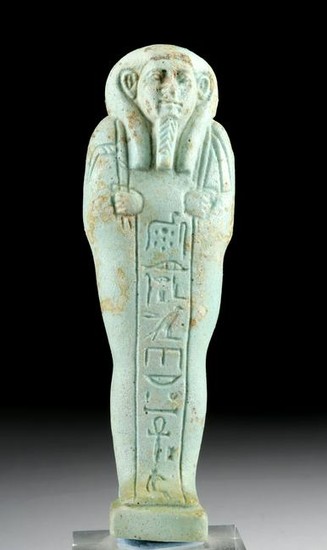Translated Egyptian Glazed Faience Ushabti for Horemheb
**Originally Listed At $1200**
Egypt, Late Dynastic Period, 26th Dynasty, ca. 664 to 525 BCE. A beautiful mold-formed faience ushabti covered in pale turquoise-hued glaze. The figure stands in mummiform atop an integral rectangular plinth, holds the symbolic pick and hoe in hands crossed atop the smooth chest, and has an incised seed bag draped over the right shoulder. The stern countenance is composed of recessed almond-shaped eyes beneath slender brows, a rigid nose with flared nostrils, pouty lips above a plaited false beard, and cupped ears, all beneath a simple tripartite wig. Both the front and back of the body display a column of inscribed hieroglyphic text, the front reading, "The illuminate, the Osiris, the renep-priest, Horemheb, son of Ankh-pa-khered," and the back reading, "Born to the lady of the house, Ta-khered-en-ta-ihe." Size: 1.2" W x 4" H (3 cm x 10.2 cm); 4.8" H (12.2 cm) on included custom stand.
The ancient Egyptians believed that after they died, their spirits would have to work in the "Field of Reeds" owned by the god of the underworld, Osiris. This meant doing agricultural labor - and it was required by all members of society, from workers to pharaohs. During the Pharaonic period, they had become so necessary and elaborate that some tombs contained one worker for every day of the year and thirty-six overseers, each responsible for ten laborers. Workers like these are from that period of enormous proliferation, and are some of our best surviving insights into ancient Egyptian funerary practices.
Provenance: private East Coast, USA collection; ex-private Arizona, USA collection, acquired in the 1980s
All items legal to buy/sell under U.S. Statute covering cultural patrimony Code 2600, CHAPTER 14, and are guaranteed to be as described or your money back.
A Certificate of Authenticity will accompany all winning bids.
We ship worldwide to most countries and handle all shipping in-house for your convenience.
#146178
Condition Report: Light fading and staining to areas of original glaze pigmentation, light encrustations, and minor abrasions, otherwise intact and near-choice. Light earthen deposits throughout. Inscribed hieroglyphic text is still very clear and legible.
View it on
Sale price
Estimate
Time, Location
Auction House
**Originally Listed At $1200**
Egypt, Late Dynastic Period, 26th Dynasty, ca. 664 to 525 BCE. A beautiful mold-formed faience ushabti covered in pale turquoise-hued glaze. The figure stands in mummiform atop an integral rectangular plinth, holds the symbolic pick and hoe in hands crossed atop the smooth chest, and has an incised seed bag draped over the right shoulder. The stern countenance is composed of recessed almond-shaped eyes beneath slender brows, a rigid nose with flared nostrils, pouty lips above a plaited false beard, and cupped ears, all beneath a simple tripartite wig. Both the front and back of the body display a column of inscribed hieroglyphic text, the front reading, "The illuminate, the Osiris, the renep-priest, Horemheb, son of Ankh-pa-khered," and the back reading, "Born to the lady of the house, Ta-khered-en-ta-ihe." Size: 1.2" W x 4" H (3 cm x 10.2 cm); 4.8" H (12.2 cm) on included custom stand.
The ancient Egyptians believed that after they died, their spirits would have to work in the "Field of Reeds" owned by the god of the underworld, Osiris. This meant doing agricultural labor - and it was required by all members of society, from workers to pharaohs. During the Pharaonic period, they had become so necessary and elaborate that some tombs contained one worker for every day of the year and thirty-six overseers, each responsible for ten laborers. Workers like these are from that period of enormous proliferation, and are some of our best surviving insights into ancient Egyptian funerary practices.
Provenance: private East Coast, USA collection; ex-private Arizona, USA collection, acquired in the 1980s
All items legal to buy/sell under U.S. Statute covering cultural patrimony Code 2600, CHAPTER 14, and are guaranteed to be as described or your money back.
A Certificate of Authenticity will accompany all winning bids.
We ship worldwide to most countries and handle all shipping in-house for your convenience.
#146178
Condition Report: Light fading and staining to areas of original glaze pigmentation, light encrustations, and minor abrasions, otherwise intact and near-choice. Light earthen deposits throughout. Inscribed hieroglyphic text is still very clear and legible.



